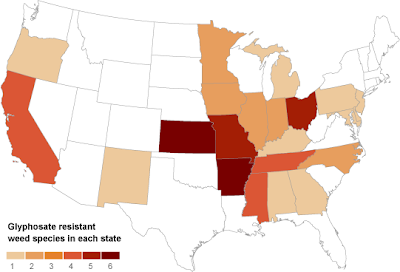To fight them, Mr. Anderson and farmers throughout the East, Midwest and South are being forced to spray fields with more toxic herbicides, pull weeds by hand and return to more labor-intensive methods like regular plowing.MUCH more at the Gray Lady article (where the embedded graphic scrolls with time to show the progression of resistance)
“We’re back to where we were 20 years ago,” said Mr. Anderson, who will plow about one-third of his 3,000 acres of soybean fields this spring, more than he has in years. “We’re trying to find out what works.”
“It is the single largest threat to production agriculture that we have ever seen,” said Andrew Wargo III, the president of the Arkansas Association of Conservation Districts.
The first resistant species to pose a serious threat to agriculture was spotted in a Delaware soybean field in 2000. Since then, the problem has spread, with 10 resistant species in at least 22 states infesting millions of acres, predominantly soybeans, cotton and corn...
The superweeds could temper American agriculture’s enthusiasm for some genetically modified crops. Soybeans, corn and cotton that are engineered to survive spraying with Roundup have become standard in American fields. However, if Roundup doesn’t kill the weeds, farmers have little incentive to spend the extra money for the special seeds.
Minggu, 09 Mei 2010
Roundup resistance is increasing
It's not enough that we have antibiotic-resistant bacteria proliferating. Now we're developing Roundup-resistant weeds.
Langganan:
Posting Komentar (Atom)


Tidak ada komentar:
Posting Komentar